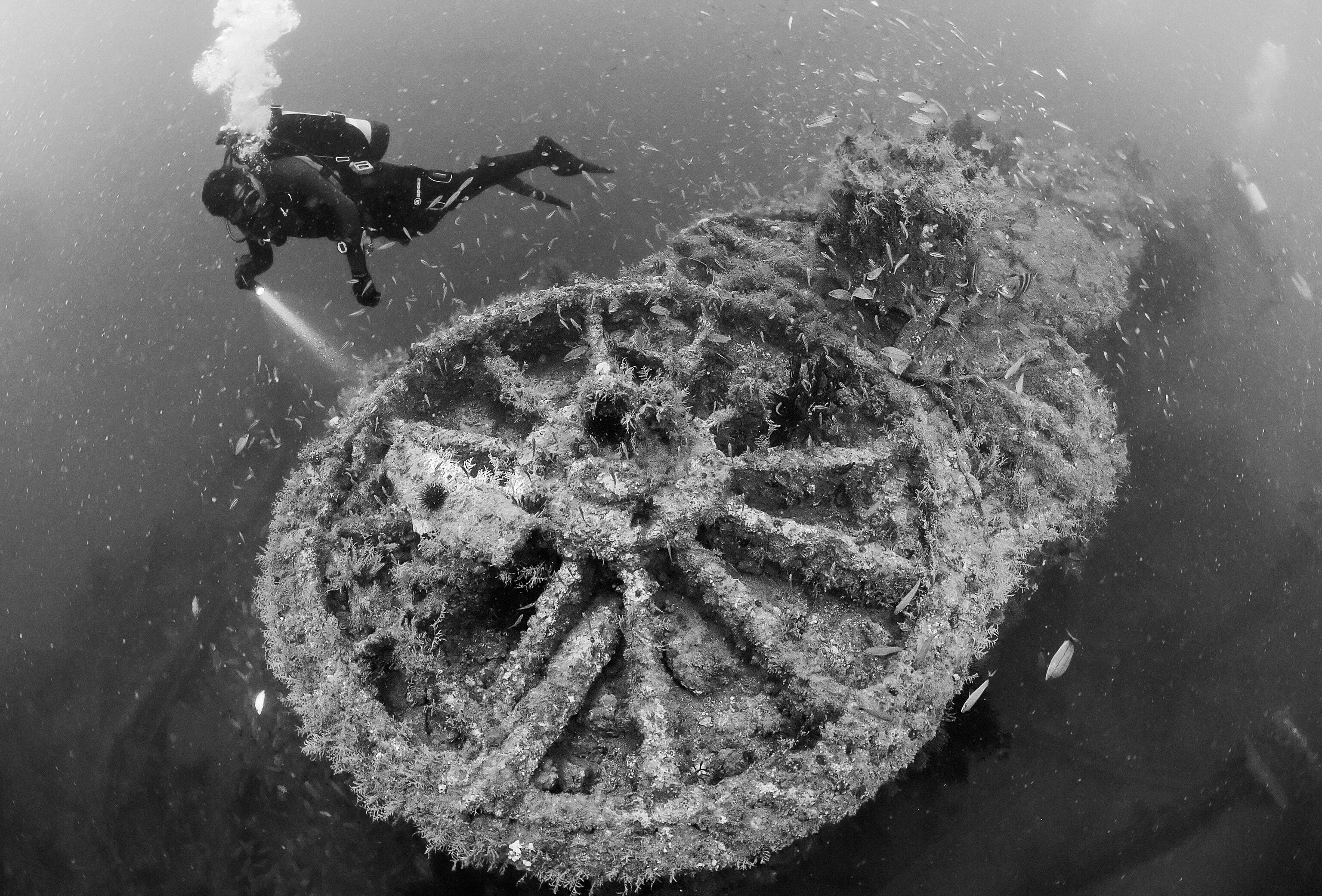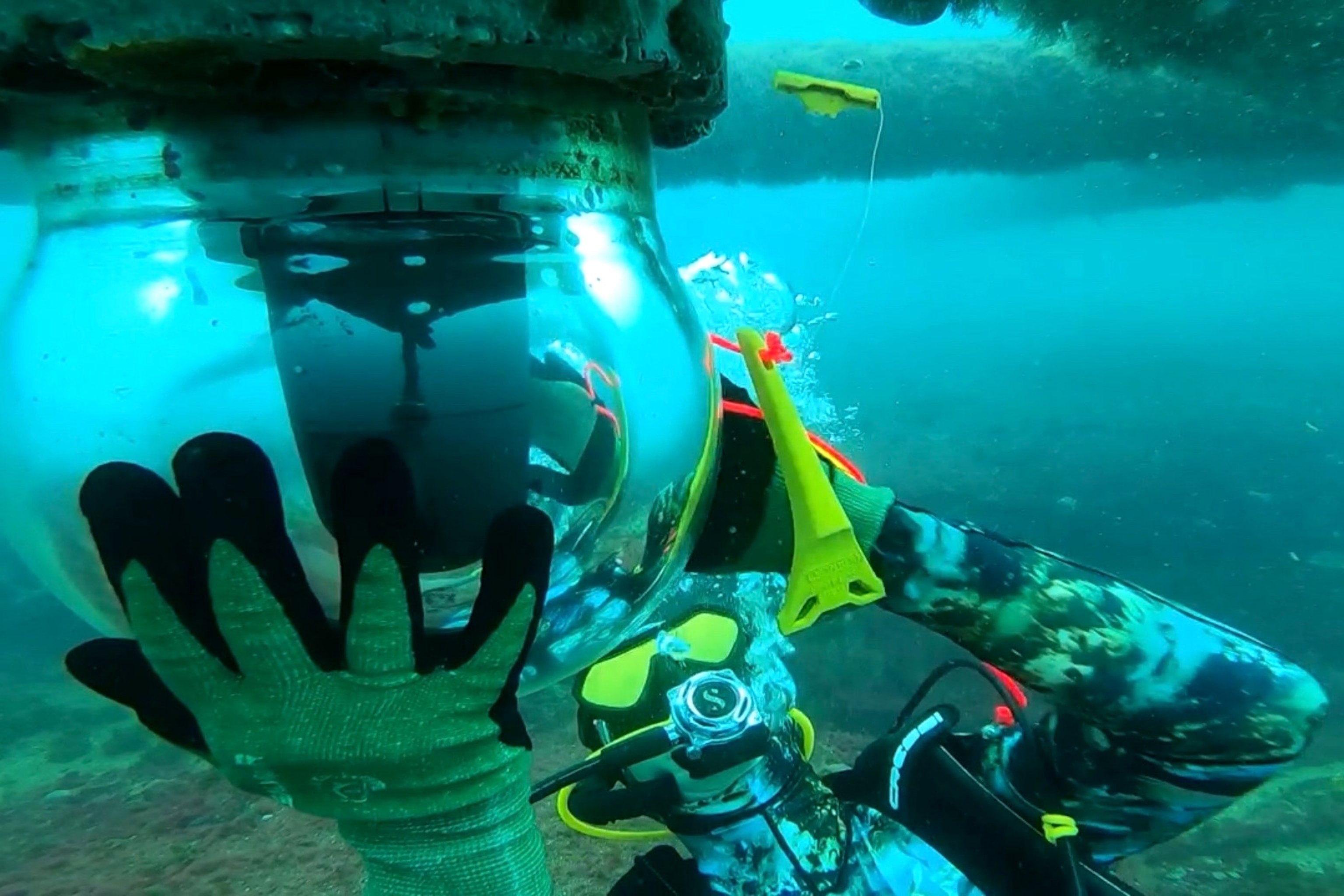
Stay overnight at this lighthouse—a thrilling 32 miles out to sea
Once a beacon for ships navigating North Carolina’s treacherous coast, Frying Pan Tower has taken on a second life as a marine outpost and eco-lodge.
“Send him up!” a fisherman says into his radio as I sit precariously on the bow of his boat, bobbing in the cold swells of the Atlantic, more than 30 miles from shore. A wooden plank beneath me lurches like a swing, lifting me upward, off the boat, and far above the water, towards the entrance to an old U.S. Coast Guard light station where I’ll be staying for the weekend.
Suddenly, the hoist shudders and comes to a halt.
“Whoops, hang on,” Richard Neal calls out calmly from the tower’s deck. For a moment I’m stuck in midair, dangling 60 feet above the sea. “I haven’t dropped anyone—yet,” Neal says with a smile, only after he’s gotten the hoist working again a few minutes later and I’ve been safely brought into the tower’s entrance.
Neal is the 62-year-old owner and manager of Frying Pan Tower: a hulking, 80-foot-tall lighthouse 32 miles off the coast of North Carolina that’s now being restored into a high-tech marine conservation outpost and eco-adventure lodge. It is an intimidating yet extraordinary place, a rare chance to spend time on—and help save—one of the few structures of its kind left in the world.
Graveyard of the Atlantic
Frying Pan Tower was built by the U.S. Coast Guard in 1964 to light the way for ships navigating North Carolina’s treacherous coastline, famously nicknamed the “Graveyard of the Atlantic” because it has seen so many shipwrecks and squalls. The tower marks the start of Frying Pan Shoals, a skillet-shaped stretch of dangerously shallow waters.

Seven of these so-called “Texas Tower” lighthouses, which look similar to offshore oil rigs, were built during the 20th century at strategic locations along the East Coast. They have not aged well. Most were first automated, and then decommissioned, left to rust in the dark until they were declared structurally unsound and eventually dismantled. Just three remain standing today: Diamond Shoals Light, off the coast of North Carolina’s Cape Hatteras; Chesapeake Light, marking the entrance to the Chesapeake Bay in Virginia; and Frying Pan Tower.
(America’s women lighthouse keepers are finally being seen.)
An eco-adventure like none other
Frying Pan is the only one at least somewhat accessible to the public. In 2010, Neal bought the tower at auction from the U.S. government for $85,000, but he has since divested his ownership, and now runs a nonprofit tasked with its preservation and renewal.
Volunteers willing to help with restoration work can join Neal at Frying Pan. They must cover their own transportation costs—usually a few hundred dollars to hitch a bouncy, two-hour boat ride with fishermen (or more for an easy 20-minute helicopter flight). In exchange they receive free room and board.

“Depending on their skillset, they may be doing some electrical work, they might be doing some welding, they might be sweeping the floor or doing laundry,” Neal says. “Everybody that comes out here and has a heart to restore the tower gets to participate.”
Frying Pan exists completely off the grid, powered by solar panels (with a backup generator for heat and air conditioning). There are two modern bathrooms with several flushing toilets, large sinks, and hot-water showers, from which wastewater is deposited deep into the ocean. The eight bedrooms, each one named for a different North Carolina lighthouse, are far from fully renovated, but are comfortable and sparingly decorated with nautical pieces from the tower’s past—dusty life preservers, old maps, and analog weather instruments and radios.
(How to save a lighthouse? Sleep in one.)
The experience of visiting, however, is not for the faint of heart. The tower has been severely battered by the sea for more than half a century. Its massive metal pilings, drilled into the ocean floor, are covered with rust. The wraparound grated-steel platforms are loose in some areas, cordoned off with rope, and it‘s not hard to imagine an 80-foot fall to the water below. The tower was deemed structurally sound when Neal bought it 12 years ago, but it hasn’t had a proper inspection since. “We’ve had some engineers out and they think it’s still okay,” he says.
Neal and I drop fishing hooks from the tower’s platforms, but find little luck. The five other guests do, however, and we eat fish fried fresh for dinner. Sunset lights the horizon on fire. At night, atop the rooftop helipad, Neal launches fireworks towards a blanket of a million stars, while the rest of us sing folk songs around a crackling fire. The next morning, I don a wetsuit and a snorkel and again brave the hoist, which lowers me straight into a school of fish being stalked by five stealthy barracuda.


A safe haven
Safety and emergency response remain central to the tower’s mission in its second life. One evening, in the living room, I find Neal putting together a red-and-white beacon light that will shine atop the tower for the first time since he first bought it in 2010.
“We all have GPS,” Neal says, “but it will bring a level of reassurance for boaters to say, ‘There’s the tower. I see it.’”
Neal doesn’t currently live on the tower, but he has done so a few times in the past, including for a stretch in 2016, after he was laid off from his longtime job as a software salesman. “I was depressed,” he says. “So, I picked up a hammer and I got to work.”
He did not return to land for six months, relying on fishermen for food and supplies, and occasional visitors for company as he made repairs and installed new technology. Most of the time, though, he was alone. “Just staring at the stars and talking to the ocean,” Neal says, “and getting my head back on straight.”
Now Neal dedicates himself full-time to the restoration project. He opened the tower’s doors to volunteers—many of whom, a guest book on the coffee table shows, were drawn to the project for similarly personal reasons. “You see this thing out there in the middle of the ocean and you think, I can never get on there,” says Dirk Swart, a volunteer who has come on 13 work trips over the past year and a half. “And then you do, and you’re okay.”
(Discover 17 stellar new hotels that embrace their geography.)
There is something comforting about chipping away at a job so monumental that it feels as if it might never be finished. And there will always be more work to be done. Neal has hosted engineers testing remotely operated vehicles (ROVs) that aim to explore the ocean depths, and researchers setting acoustic buoys to monitor the presence of migrating whales in the Atlantic.
Among Neal’s proudest additions during the past few years has been the installation of public-access livestream cameras, both on the tower’s deck and beneath the waves; he wants to add more. At any given time, one might log on to see ships passing in the distance, or a sand tiger shark cruising the reef below. “I want this place to be a window onto the ocean for those who might not have one every day,” he says.
You May Also Like
Go Further
Animals
- The world's largest fish are vanishing without a traceThe world's largest fish are vanishing without a trace
- We finally know how cockroaches conquered the worldWe finally know how cockroaches conquered the world
- Why America's 4,000 native bees need their day in the sunWhy America's 4,000 native bees need their day in the sun
- Crowdsourcing an anti-poaching movement in South Africa
- Paid Content
Crowdsourcing an anti-poaching movement in South Africa - Fireflies are nature’s light show at this West Virginia state parkFireflies are nature’s light show at this West Virginia state park
Environment
- 2024 hurricane season forecasted to be record-breaking year2024 hurricane season forecasted to be record-breaking year
- Connecting a new generation with South Africa’s iconic species
- Paid Content
Connecting a new generation with South Africa’s iconic species - These images will help you see coral reefs in a whole new wayThese images will help you see coral reefs in a whole new way
- What rising temps in the Gulf of Maine mean for wildlifeWhat rising temps in the Gulf of Maine mean for wildlife
- He’s called ‘omacha,’ a dolphin that transforms into a man. Why?He’s called ‘omacha,’ a dolphin that transforms into a man. Why?
History & Culture
- Why this Bronze Age village became known as ‘Britain’s Pompeii’Why this Bronze Age village became known as ‘Britain’s Pompeii’
- These modern soldiers put Bronze Age armor to the testThese modern soldiers put Bronze Age armor to the test
- Should couples normalize sleeping in separate beds?Should couples normalize sleeping in separate beds?
- They were rock stars of paleontology—and their feud was legendaryThey were rock stars of paleontology—and their feud was legendary
Science
- Why the world's oldest sport is still one of the best exercisesWhy the world's oldest sport is still one of the best exercises
- What if aliens exist—but they're just hiding from us?What if aliens exist—but they're just hiding from us?
- Can a spoonful of honey keep seasonal allergies at bay?Can a spoonful of honey keep seasonal allergies at bay?
- Scientists just dug up a new dinosaur—with tinier arms than a T.RexScientists just dug up a new dinosaur—with tinier arms than a T.Rex
Travel
- Visit Rotterdam as it transforms itself into a floating cityVisit Rotterdam as it transforms itself into a floating city
- How to get off the beaten track in Northern LanzaroteHow to get off the beaten track in Northern Lanzarote






